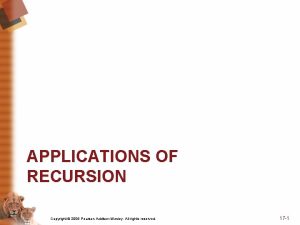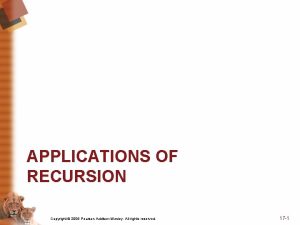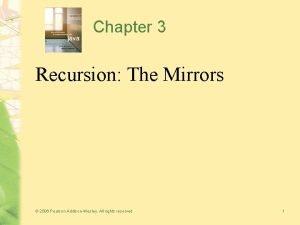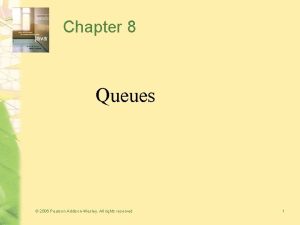More on Recursion 2006 Pearson AddisonWesley All rights



















![Actual Running Time • Consider the following pseudocode algorithm: Given input n int[] n_by_n Actual Running Time • Consider the following pseudocode algorithm: Given input n int[] n_by_n](https://slidetodoc.com/presentation_image/ea29a7bf7dccbb2ccfb860f73e359d51/image-20.jpg)






















- Slides: 42

More on Recursion © 2006 Pearson Addison-Wesley. All rights reserved 1

Backtracking • Backtracking – A strategy for guessing at a solution and backing up when an impasse is reached • Recursion and backtracking can be combined to solve problems © 2006 Pearson Addison-Wesley. All rights reserved 2

The Eight Queens Problem • Problem – Place eight queens on the chessboard so that no queen can attack any other queen • Strategy: guess at a solution – There are 4, 426, 165, 368 ways to arrange 8 queens on a chessboard of 64 squares © 2006 Pearson Addison-Wesley. All rights reserved 3

The Eight Queens Problem • An observation that eliminates many arrangements from consideration – No queen can reside in a row or a column that contains another queen • Now: only 40, 320 arrangements of queens to be checked for attacks along diagonals © 2006 Pearson Addison-Wesley. All rights reserved 4

The Eight Queens Problem • Providing organization for the guessing strategy – Place queens one column at a time – If you reach an impasse, backtrack to the previous column © 2006 Pearson Addison-Wesley. All rights reserved 5

The Eight Queens Problem Figure 6 -1 a) Five queens that cannot attack each other, but that can attack all of column 6; b) backtracking to column 5 to try another square for the queen; c) backtracking to column 4 to try another square for the queen and then considering column 5 again © 2006 Pearson Addison-Wesley. All rights reserved 6

The Eight Queens Problem • A recursive algorithm that places a queen in a column – Base case • If there are no more columns to consider – You are finished – Recursive step • If you successfully place a queen in the current column – Consider the next column • If you cannot place a queen in the current column – You need to backtrack © 2006 Pearson Addison-Wesley. All rights reserved 7

The Eight Queens Problem Figure 6 -2 A solution to the Eight Queens problem © 2006 Pearson Addison-Wesley. All rights reserved 8

The Relationship Between Recursion and Mathematical Induction • A strong relationship exists between recursion and mathematical induction • Induction can be used to – Prove properties about recursive algorithms – Prove that a recursive algorithm performs a certain amount of work © 2006 Pearson Addison-Wesley. All rights reserved 9

The Correctness of the Recursive Factorial Method • Pseudocode for a recursive method that computes the factorial of a nonnegative integer n fact(n) if (n is 0) { return 1 } else { return n * fact(n – 1) } © 2006 Pearson Addison-Wesley. All rights reserved 10

The Correctness of the Recursive Factorial Method • Induction on n can prove that the method fact returns the values fact(0) = 0! = 1 fact(n) = n! = n * (n – 1) * (n – 2) * …* 1 if n > 0 Proof: for n=0, returns 1 assume fact(k) returns k! then fact(k+1) returns (k+1)*fact(k) = (k+1)*k! = k! © 2006 Pearson Addison-Wesley. All rights reserved 11

The Cost of Towers of Hanoi • Solution to the Towers of Hanoi problem solve. Towers(count, source, destination, spare) if (count is 1) { Move a disk directly from source to destination } else { solve. Towers(count-1, source, spare, destination) solve. Towers(1, source, destination, spare) solve. Towers(count-1, spare, destination, source) } © 2006 Pearson Addison-Wesley. All rights reserved 12

The Cost of Towers of Hanoi • Question – If you begin with N disks, how many moves does solve. Towers make to solve the problem? • Let – moves(N) be the number of moves made starting with N disks • When N = 1 – moves(1) = 1 © 2006 Pearson Addison-Wesley. All rights reserved 13

The Cost of Towers of Hanoi • When N > 1 moves(N) = moves(N – 1) + moves(N – 1) • Recurrence relation for the number of moves that solve. Towers requires for N disks moves(1) = 1 moves(N) = 2 * moves(N – 1) + 1 © 2006 Pearson Addison-Wesley. All rights reserved if N > 1 14

The Cost of Towers of Hanoi • A closed-formula for the number of moves would be nicer • Induction on N can provide the proof that moves(N) = 2 N – 1 – base N=0: moves(N) = 1 – assume moves(k) = 2 k – 1: moves(k+1) = 2*moves(k) + 1 = 2*(2 k – 1) + 1 = 2 k+1 – 1 © 2006 Pearson Addison-Wesley. All rights reserved (recursive) (hypothesis) (arithmetic) 15

Algorithm Efficiency © 2006 Pearson Addison-Wesley. All rights reserved 16

Measuring the Efficiency of Algorithms • Analysis of algorithms – Provides tools for contrasting the efficiency of different methods of solution • A comparison of algorithms – Should focus of significant differences in efficiency – Should not consider reductions in computing costs due to clever coding tricks © 2006 Pearson Addison-Wesley. All rights reserved 17

Measuring the Efficiency of Algorithms • Three difficulties with comparing programs instead of algorithms – How are the algorithms coded? – What computer should you use? – What data should the programs use? • Algorithm analysis should be independent of – Specific implementations – Computers – Data © 2006 Pearson Addison-Wesley. All rights reserved 18

The Execution Time of Algorithms • Counting an algorithm's operations is a way to access its efficiency – An algorithm’s execution time is related to the number of operations it requires – Examples • The Towers of Hanoi • Nested Loops © 2006 Pearson Addison-Wesley. All rights reserved 19
![Actual Running Time Consider the following pseudocode algorithm Given input n int nbyn Actual Running Time • Consider the following pseudocode algorithm: Given input n int[] n_by_n](https://slidetodoc.com/presentation_image/ea29a7bf7dccbb2ccfb860f73e359d51/image-20.jpg)
Actual Running Time • Consider the following pseudocode algorithm: Given input n int[] n_by_n = new int[n][n]; for i<n, j<n set n_by_n[i][j] = random(); print “The random array is created”; © 2006 Pearson Addison-Wesley. All rights reserved 20

Actual Running Time • How many steps does it take for input n? – 1 step: declare an n by n array – n 2 steps: put random numbers in the array – 1 step: print out the final statement • Total steps: n 2 + 2 • Note: the extra 2 steps don’t carry the same importance as the n 2 steps – as n gets big… the extra steps are negligible © 2006 Pearson Addison-Wesley. All rights reserved 21

Actual Running Time • We also think of constants as negligible – we want to say n 2 and c*n 2 have “essentially” the same running time as n increases – more accurately: the same asymptotic running time • Commercial programmers would argue here… constants can matter in practice © 2006 Pearson Addison-Wesley. All rights reserved 22

Actual Running Time • But for large n, the constants don’t matter nearly as much • Plug in n=1000 – n 2+500 = 1000500 – 2 n 2 = 2000000 – n 3 = 100000 – 2 n = 10301 (approx) © 2006 Pearson Addison-Wesley. All rights reserved [+500] [+100000] [+999000000] [+ 10301 ] 23

Algorithm Growth Rates • An algorithm’s time requirements can be measured as a function of the problem size • An algorithm’s growth rate – Enables the comparison of one algorithm with another – Examples Algorithm A requires time proportional to n 2 Algorithm B requires time proportional to n • Algorithm efficiency is typically a concern for large problems only © 2006 Pearson Addison-Wesley. All rights reserved 24

Algorithm Growth Rates Figure 10 -1 Time requirements as a function of the problem size n © 2006 Pearson Addison-Wesley. All rights reserved 25

Order-of-Magnitude Analysis and Big O Notation • Definition of the order of an algorithm A is order f(n) – denoted O(f(n)) – if constants k and n 0 exist such that A requires no more than k * f(n) time units to solve a problem of size n ≥ n 0 • Growth-rate function – A mathematical function used to specify an algorithm’s order in terms of the size of the problem © 2006 Pearson Addison-Wesley. All rights reserved 26

Big O Notation • Running time will be measured with Big-O notation • Big-O is a way to indicate how fast a function grows © 2006 Pearson Addison-Wesley. All rights reserved 27

Big-O Notation • When we say an algorithm has running time O(n): – we are saying it runs in the same time as other functions with time O(n) – we are describing the running time ignoring constants – we are concerned with large values of n © 2006 Pearson Addison-Wesley. All rights reserved 28

Big-O Rules • Ignore constants: – O(c * f(n)) = O(f(n)) • Ignore smaller powers: – O(n 3 + n) = O(n 3) • Logarithms cost less than a power – Think of log n as equvialent to n 0. 000…. 001 – O(na+0. 1) > O(na log n) > O(na) – e. g. O(n log n + n) = O(n log n) – e. g. O(n log n +n 2) = O(n 2) © 2006 Pearson Addison-Wesley. All rights reserved 29

Order-of-Magnitude Analysis and Big O Notation • Order of growth of some common functions O(1) < O(log 2 n) < O(n * log 2 n) < O(n 2) < O(n 3) < O(2 n) • Properties of growth-rate functions – You can ignore low-order terms – You can ignore a multiplicative constant in the highorder term – O(f(n)) + O(g(n)) = O(f(n) + g(n)) © 2006 Pearson Addison-Wesley. All rights reserved 30

Why Big-O? • Look at what happens for large inputs – small problems are easy to do quickly – big problems are more interesting – larger function makes a huge difference for big n • Ignores irrelevant details – Constants and lower order terms depend on implementation… Big-O focuses on the algorithm © 2006 Pearson Addison-Wesley. All rights reserved 31

Order-of-Magnitude Analysis and Big O Notation Figure 10 -3 a A comparison of growth-rate functions: a) in tabular form © 2006 Pearson Addison-Wesley. All rights reserved 32

Order-of-Magnitude Analysis and Big O Notation Figure 10 -3 b A comparison of growth-rate functions: b) in graphical form © 2006 Pearson Addison-Wesley. All rights reserved 33

Determining Running Time • Need to count the number of “steps” to complete – need to consider the worst case – for input of size n – a “step” must take constant (O(1)) time • Often: – iterations of the inner loop * work per loop – recursive calls * work per call © 2006 Pearson Addison-Wesley. All rights reserved 34

Why Does log Keep Coming Up? • By default, we write log n for log 2 n • High school math: – logb c = e means be = c – so: log 2 n is the inverse of 2 n • log 2 n is the power of 2 that gives result n © 2006 Pearson Addison-Wesley. All rights reserved 35

Why Does log Keep Coming Up? • Exponential algorithm – O(2 n) – Increasing input by 1 doubles running time • Logarithmic algorithm – log n – The inverse of doubling… – Doubling input size increases running time by 1 – Intuition: • O(log n) means that every step in the algorithm divides the problem size in half © 2006 Pearson Addison-Wesley. All rights reserved 36

Example 1: Search • Linear search: – checks each element in array – just a constant number of other steps – O(n) - “order n” • Binary search: – chops array in half with each step – n n/2 n/4 n/8 …. 2 1 – takes log n steps: O(log n) - “order log n” © 2006 Pearson Addison-Wesley. All rights reserved 37

Example 2 • Recursive algorithm Power 1 – Power 1(x, 1) = x – Power 1(x, y) = x* xy-1 • Recursive algorithm Power 2 – Power 2(x, 1) = x – Power 2(x, y) = xy/2 * xy/2 © 2006 Pearson Addison-Wesley. All rights reserved 38

Example 2 • Power 1: – xy = x * xy-1 – makes y recursive calls: O(y) • Power 2: – xy = xy/2 * xy/2 – Makes log y recursive calls: O(log y) – Have to be careful not to compute xy/2 twice © 2006 Pearson Addison-Wesley. All rights reserved 39

Order-of-Magnitude Analysis and Big O Notation • Worst-case and average-case analyses – An algorithm can require different times to solve different problems of the same size • Worst-case analysis – A determination of the maximum amount of time that an algorithm requires to solve problems of size n • Average-case analysis – A determination of the average amount of time that an algorithm requires to solve problems of size n © 2006 Pearson Addison-Wesley. All rights reserved 40

Keeping Your Perspective • Throughout the course of an analysis, keep in mind that you are interested only in significant differences in efficiency • Some seldom-used but critical operations must be efficient © 2006 Pearson Addison-Wesley. All rights reserved 41

Keeping Your Perspective • If the problem size is always small, you can probably ignore an algorithm’s efficiency • Weigh the trade-offs between an algorithm’s time requirements and its memory requirements • Compare algorithms for both style and efficiency • Order-of-magnitude analysis focuses on large problems © 2006 Pearson Addison-Wesley. All rights reserved 42
 More more more i want more more more more we praise you
More more more i want more more more more we praise you More more more i want more more more more we praise you
More more more i want more more more more we praise you To understand recursion you must understand recursion
To understand recursion you must understand recursion 2012 pearson education inc
2012 pearson education inc Pearson education inc. all rights reserved
Pearson education inc. all rights reserved Pearson education inc. all rights reserved
Pearson education inc. all rights reserved Pearson education inc all rights reserved
Pearson education inc all rights reserved Pearson education inc. all rights reserved
Pearson education inc. all rights reserved All of you is more than enough for all of me
All of you is more than enough for all of me Positive rights vs negative rights
Positive rights vs negative rights What are littoral rights
What are littoral rights Legal rights and moral rights
Legal rights and moral rights Legal rights and moral rights
Legal rights and moral rights Positive vs negative rights
Positive vs negative rights Positive vs negative rights
Positive vs negative rights Positive rights vs negative rights
Positive rights vs negative rights Positive rights and negative rights
Positive rights and negative rights Draw three noncollinear points j k and l
Draw three noncollinear points j k and l 2011 pearson education inc
2011 pearson education inc Pearson education inc publishing as pearson prentice hall
Pearson education inc publishing as pearson prentice hall Bob whelan pearson
Bob whelan pearson Stress management for life 5th edition
Stress management for life 5th edition Pearson education inc publishing as pearson prentice hall
Pearson education inc publishing as pearson prentice hall Pearson 2012
Pearson 2012 Pearson education inc publishing as pearson prentice hall
Pearson education inc publishing as pearson prentice hall Chapter 12 lesson 3
Chapter 12 lesson 3 The more you take the more you leave behind
The more you take the more you leave behind The more you study the more you learn
The more you study the more you learn Aspire not to
Aspire not to More inertia
More inertia Knowing more remembering more
Knowing more remembering more More love to thee o lord
More love to thee o lord More choices more chances
More choices more chances Human history becomes more and more a race
Human history becomes more and more a race All rights reserved example
All rights reserved example Copyright 2015 all rights reserved
Copyright 2015 all rights reserved All rights reserved sentence
All rights reserved sentence Freesound content licence
Freesound content licence Confidential all rights reserved
Confidential all rights reserved Sentinel-controlled loop pseudocode
Sentinel-controlled loop pseudocode Copyright © 2015 all rights reserved
Copyright © 2015 all rights reserved Microsoft corporation. all rights reserved.
Microsoft corporation. all rights reserved. Microsoft corporation. all rights reserved
Microsoft corporation. all rights reserved


































































